Understanding the various types of car accidents is crucial to promoting safer driving practices. It helps people prepare for unforeseen circumstances. From rear-end collisions to deadly head-on crashes, each type often embodies specific causes and legal considerations.
By familiarizing yourself with these accidents, you equip yourself to not only prevent incidents. You also learn to handle them effectively should they occur. So in this article, we’ll explore the different types of car crashes that every driver should know about.
So hop in and buckle up for the ride!
Rear-End Collisions: The Common Fender Bender
Rear-end collisions top the charts as the most frequent type of accident involving vehicles. These occur when a vehicle abruptly stops, and the following car fails to brake in time.
The injuries associated with rear-enders can be significant. In legal terms, the rear driver is usually considered at fault. This is because they have failed to maintain a safe following distance.
Side-Impact (T-Bone) Collisions: A Pertinent Threat at Intersections
Side-impact accidents are also known as T-bone collisions. They happen when two vehicles collide at a nearly straight angle from the front.
These can happen at intersections, often due to running red lights or stop signs. They can also occur when a driver makes an improper turn. They also happen when you change lanes without checking your blind spot.
The injuries from these collisions can be severe. It just depends on the location of the impact and the speed of the vehicles involved. Drivers should always exercise caution at intersections to avoid these dangerous crashes.
Head-On Collisions: High-Stakes, High-Speed Crashes
A head-on collision is a major car accident and is among the deadliest types of accidents on the road. They occur when two vehicles collide front to front, often at high speeds.
These crashes can result in catastrophic injuries or fatalities due to the immense force involved. The causes of head-on collisions vary, from driver fatigue to distracted driving and even drunk driving.
Drivers should always be vigilant. You should stay within your designated lanes. And you should avoid distractions to prevent this type of accident.
Single-Vehicle Accidents: More Than Just Mechanical Errors
Single-vehicle collisions are those that involve only one vehicle. They can occur in various ways, such as running into a fixed object or rolling over.
While mechanical issues may be the cause of some single-vehicle accidents, there are often other factors involved. These include driver error, road conditions, and environmental factors like weather.
That’s why it’s always essential to practice safe driving habits even if you’re alone on the road. Be aware of your surroundings to reduce the risk of accidents.
Side-Swipe Collisions: Often a Prelude to More Dangerous Accidents
Side-swipe collisions occur when two vehicles traveling in the same direction make contact with each other. These accidents can happen when a driver changes lanes without signaling or checking their blind spot.
While these may seem like minor incidents, they often lead to more severe crashes. So you should always use your signals. You should also check your blind spot before changing lanes to avoid side-swipe collisions.
Rollover Accidents: The Catastrophic Consequence of Unbalanced Forces
Rollover accidents are when a vehicle tips onto its side or roof. They can happen due to sharp turns, overcorrection, or collisions with other vehicles or objects.
SUVs and trucks are more susceptible to rollover accidents due to their higher center of gravity. The injuries from these crashes can be severe, ranging from broken bones to spinal cord injuries.
When driving, it’s crucial to maintain control of your vehicle and avoid abrupt turns or maneuvers that can cause rollovers. It’s also essential to ensure that your vehicle is well-maintained and in optimal condition.
Multi-Vehicle Pileups: A Melee of Destruction
Multi-vehicle accidents, or pileups, involve three or more vehicles in a chain reaction of collisions. Pileups often occur on highways.
They also happen during adverse weather conditions. For example, when there is thick fog, road visibility decreases. This pushes drivers into accidents.
The complex nature of these accidents makes it difficult to determine fault. They require careful investigation.
Hit-and-Run Accidents: The Legal and Moral Puzzle
Hit-and-run accidents involve a driver leaving the scene of an accident without stopping. These incidents can result in criminal charges for the fleeing driver.
If you are involved in a hit-and-run, it’s crucial to remain calm. Gather as much information as possible. This includes the license plate number or vehicle description.
Reporting these accidents can help authorities track down the driver. Additionally, hiring a car accident lawyer can help you navigate the legal complexities. They can help you seek compensation for any damages or injuries.
Pedestrian and Cyclist Collisions: Vulnerable Road Users
Pedestrians and cyclists are the most vulnerable road users. They do not have the protection of a vehicle. Collisions involving these individuals can result in severe injuries or fatalities.
Drivers should always be cautious when sharing the road with pedestrians and cyclists. It’s essential to follow traffic laws. You need to yield to pedestrians at crosswalks.
Weather-Related Accidents: When Nature Becomes a Road Hazard
Adverse weather conditions, such as rain, snow, or ice, can impact driving and lead to accidents. These conditions reduce visibility and affect the vehicle’s handling.
To prevent weather-related accidents, you should always adjust your speed according to the road conditions. It’s also essential to maintain a safe following distance and avoid sudden maneuvers.
Animal-Related Accidents: The Unpredictable Road Hazard
Animal-related accidents occur when a vehicle collides with an animal crossing the road. These are common in rural areas and regions where wildlife is abundant. Large animals like deer can cause significant damage to vehicles and serious injury to passengers.
To mitigate the risk of animal-related accidents, you should be vigilant during dawn and dusk. These are times when animals are most active.
It’s also important to slow down in areas known for wildlife crossings. You need to use high-beam headlights whenever possible to increase visibility at night. You should always be cautious of oncoming traffic to prevent blinding other drivers.
Different Types of Car Accidents, One Common Goal: Safer Driving Practices
Understanding the various types of car accidents is essential for all drivers. It helps promote safer driving habits and prepares individuals for potential incidents on the road.
Remember, safe driving is not just about protecting yourself but also those around you. By staying informed and practicing defensive driving, we can all work towards reducing the number of car accidents on our roads.
Stay safe out there! Buckle up and drive responsibly.

